(Webmaster's note: All images are "clickable" for a larger image, and links are included to assist research. Unless otherwise stated, all images kindly supplied by Harry Fraser-Mitchell of the Handley Page Association.)
Sir
Frederick Handley Page (1885-1962), knighted in 1942 for his services to the war effort,
registered Handley Page Limited, way back in 1909, as the first Company in the
world to be formed solely for the design and manufacture of aircraft.
Together with his innovative chief designer George Volkert, who joined the
Company in 1912, Frederick Handley Page pioneered the development of large
aircraft during the 1914-18 War. Drawing on this experience, and held in
great esteem by the Air Ministry, George Volkert was responsible for many
different designs of Handley Page civil and military aircraft, culminating in
the robust yet versatile Halifax bomber of which 6178 were built. In the
book, The British Bomber since
1914, dedicated to George Volkert “In appreciation of his significant
contribution to the evolution of the British bomber”, Peter Lewis wrote: “The
decision (to incorporate four Merlin engines) was instrumental in producing the
most celebrated Handley Page bomber of all, the Halifax, a magnificent machine
destined to play a very significant part in the overthrow of the Axis Powers
during the 1939-45 War”. Praise for the Halifax also came several years
after the war ended in the book British
Aircraft of World War II
compiled by David Mondey who stated: “This
Handley Page masterpiece acquired the affectionately bestowed nickname of
Halibag, an affection which most probably stemmed from its punishment-absorbing
get-you-home durability”.
So the scene is now set. Great Britain is at war!
The Halifax has been well-designed on the split construction principle, originated and developed by Handley Page, dividing the aircraft into strong major sections each of which could be subdivided and manufactured at widely dispersed shadow factories.
This prevented disruption of production by enemy action and an unexpected bonus was that in a crash landing the Halifax had a tendency to break up into its major sections letting the crews escape almost uninjured.
Large contracts for Halifaxes were placed by the Ministry of Aircraft Production to fulfill the requirements of the Royal Air Force and other Allied forces flying alongside them. However in 1940 these contracts were beyond the capacity of Handley Page’s factories at Cricklewood and Radlett but the split construction principle enabled the capacity of several engineering companies, many new to aircraft production, to be utilized. These companies included Park Royal Coachworks (PRC) in Abbey Road, London N.W.10 where a large new Aircraft Factory was built between the existing factory and the Grand Union Canal to manufacture Halifax outer wings, engine cowlings and nacelles (the outer casing of an aircraft's engine).
|
The Aircraft Factory at Park Royal Coachworks viewed from across the Grand Union Canal. |
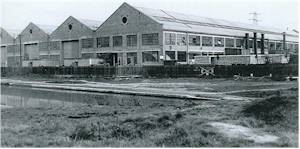 |
|
|
|
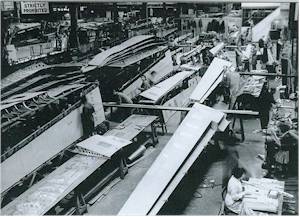 |
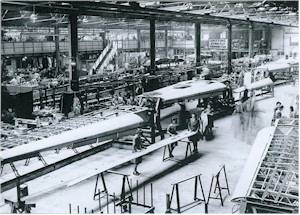 |
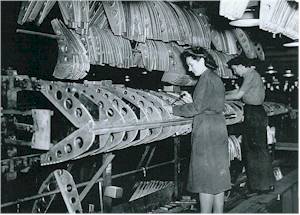 |
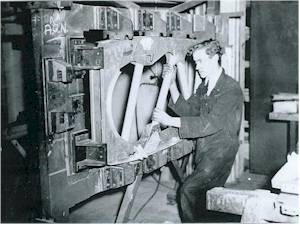 |
|
Detail assembly of an Halifax outer wing at the PRC Aircraft Factory. |
Halifax outer wing part being assembled in a jig at the PRC Aircraft Factory. |
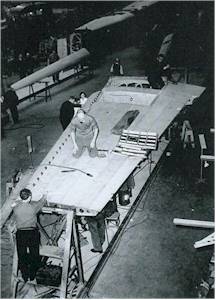 |
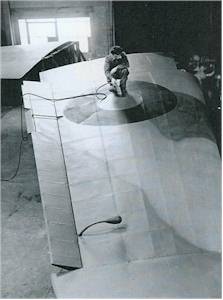 |
|
Assembly of an Halifax outer wing at the PRC Aircraft Factory. |
Spraying an Halifax outer wing and aileron at the PRC Aircraft Factory. |
|
|
PRC was part of the London Aircraft Production Group (LAPG) headed by London Transport (LPTB) which also included Express Motor & Body Works, Chrysler Motors, Duples and the LPTB works at Aldenham, Chiswick & White City, and Leavesden Aerodrome near Watford, where the 710 Halifaxes built by LAPG were assembled and test flown. Handley Page was known as the parent-firm and the companies in the Group became daughter-firms with dominion status. Each Halifax was virtually hand built and in order to maintain a high standard of production one aircraft from each hundred produced by LAPG was flown to Radlett for check-testing by Handley Page pilots with any adjustments necessary reported back to LAPG. Halifax production enabled PRC and the other daughter-firms to learn much about the use of light alloys but in return they taught Handley Page about interchangeability, particularly in the early days.
|
Test flown in December 1941 the first of the 710 Halifaxes produced by LAPG incorporating PRC manufactured parts was a Type B Mk II serial No BB189. Here: pictured alongside a London Transport bus on December 8th 1941; the first Halifax bomber assembled by the LAPG at Leavesden Aerodrome, Hertfordshire is a Type B MkII Serial No BB189. |
Following a special event attended by VIPs held at Leavesden Aerodrome to mark the completion of this aircraft, its delivery flight to the RAF was on 10 January 1942. Production of Halifaxes and large quantities of spares by LAPG continued at an increasing pace throughout the war. Lord Ashfield, the Chairman of both LAPG and LPTB in a speech made in December 1944 said: “Five undertakings not previously associated in business and with no common link have been forged into an effective production unit and have worked together in the closest harmony”.
|
April 16th 1945 was a red-letter day because the last LAPG Handley Page Halifax, a Type B Mark III Serial No PN 640 was named London Pride in a ceremony at Leavesden Aerodrome followed by an awesome low level flying display and delivery to the RAF. Right: Halifax PN460 taking off after having been named "London Pride" on 16 April 1945. This was the last of the 710 Halifax's built by the LAPG which included PRC.
|
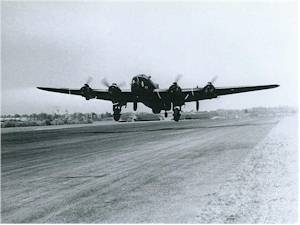 |
|
Left: The last of the 710 Halifax's built by the London Aircraft Production Group giving a low-level flying display after having been named "London Pride" on 16 April 1945. Photograph from "Handley Page - A History" by Alan Dowsett published by Tempus Publishing March 2003 - (ISBN 0752427822) |
A month prior to this ceremony a luncheon was held at the Dorchester Hotel in London on 20 March 1945 to mark the ending of wartime production of Halifaxes. Sir Frederick Handley Page proposed a toast to the daughter-firms before presenting silver models of the Halifax to the heads of each firm and scrolls of commendation to representative workers, half of whom had been women. And so at last Park Royal Coachworks and the other daughter-firms were able to return to peacetime production.
If reading this has whetted your appetite to learn more about the Handley Page Halifax including its design, development and wartime and post-war use, please Google Handley Page for many websites dedicated to the marque.
If you like to read magazines there is an excellent illustrated feature about the Halifax on pages 51 to 74 in the Database section of the May 2003 issue of "Aeroplane" by the Handley Page Association’s Harry Fraser-Mitchell.
Should you prefer books, I can recommend "Halifax - Second to None" by Victor Bingham (ISBN 0906393663) and "The Handley Page Halifax" by Ken A Merrick (ISBN 0946627606) who wrote in his introduction: “The record stands, a most distinguished one for all who built the Halifax, maintained it and flew in it. To all concerned this work is respectfully dedicated”.
© David Lang - January 2005.
Postscript: Flight Sergeant Harry Hansell, a Canadian flying as an Air Gunner in Halifax LK917 of 434 Squadron RCAF gave his life when aged only 20 in 1943. Here you can read a poignant account of his short courageous life. His story encapsulates the bravery of aircrew who gave their lives for our freedom while flying the Halifax during World War II. As it says in the introduction "His story speaks for the lives of many whose stories were never fully known, or have since been forgotten". Link to Harry's Story.
Postscript December 2006: As mentioned in Wikipedia: On the 26th of November 2006, archaeologists from the Warsaw Uprising Museum in Poland, presented the remains of Halifax (JP276 "A") that was found in southern Poland, near the city of Dabrowa Tarnowska. It was shot down on the night of the 4th/5th of August 1944 whilst returning from the "air-drop-action" during the Warsaw uprising. This is particularly significant, as this is the first wreckage of a London Aircraft Production Group built Halifax, including its Park Royal Coachworks built parts, to have been recovered.
Postscript October 2007: There are only two fully restored Halifax bombers in the world. They can be found at: The Yorkshire Air Museum at Elvington (here is the direct link to LV907 "Friday the 13th") and; The National Air Force Museum of Canada at Trenton Ontario (here is the direct link to NA337). However there is also a third Halifax which is preserved as a crashed aircraft, in an unrestored state, at the Royal Air Force Museum at Hendon (here is the direct link to W1048).
Postscript March 2009: An excellent site dedicated to the RAF Bomber Command that tells the story of the aircrews, airmen and airwomen and their contribution to victory in the Second World War, can be found here.
Postscript July 2012: The website 'www.handlypage.com' previously mentioned in the article above is no longer operational however the Handley Page Association can be found here.